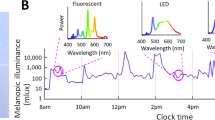Abstract
Seven first-grade children with conduct disorders and/or hyperactivity attended full-day sessions at a laboratory school classroom. During an 8- week period, the classroom lighting conditions alternated at the end of each week. During oddnumbered weeks, the classroom was illuminated by a standard coolwhite fluorescent system. On even-numbered weeks, illumination was a daylightsimulating fluorescent system of equal footcandles with controls for purported soft X rays and radio frequency (RF). There were no effects of lighting conditions on hyperactive behavior as assessed by (a) independent observations of task orientation or (b) ratings of activity level. A Critical Flicker Fusion (CFF) measure, a reported indicator of visual-sensory fatigue, indicated that the daylight-simulating condition was associated with a decreasing CFF across weeks.
Similar content being viewed by others
Reference note
Quay, H. C., & Peterson, D. R.Manual for the behavior problem checklist. Unpublished manuscript, University of Miami, 1975.
References
Coleman, R. S., Frankel, F., Ritvo, E., & Freeman, B. J. The effects of fluorescent and incandescent illumination upon repetitive behaviors in autistic children.Journal of Autism and Childhood Schizophrenia, 1976,6, 157–167.
Herron, P. L., & LaGuisa, F. L. Brightness variations affect deaf learners' attention.Lighting Design and Application, 1975,February, 30–34.
LaGuisa, F. L., & Perney, L. R. Brightness patterns influence attention spans.Lighting Design and Application, 1974,May, 26–30.
Maas, J. B., Jayson, J. K., & Kleiber, D. A. Effects of spatial differences in illumination on fatigue.Journal of Applied Psychology, 1974,59, 524–526.
Mayron, L. M., Ott, J. N., Nations, R., & Mayron, E. L. Light, radiation, and academic behavior: Initial studies on the effects of full-spectrum lighting and radiation shielding on behavior and academic performance of school children.Academic Therapy, 1974,10, 33–47.
Ross, D. M., & Ross, S. A.Hyperactivity: Research, theory and action. New York: Wiley-Interscience, 1976.
Simonson, E., & Enzer, N. Measurement of fusion frequency of flicker as a test of fatigue of the central nervous system.Journal of Industrial Hygiene and Toxicology, 1941,23, 83–89.
Woodworth, R. S., & Schlosberg, H.Experimental psychology. New York: Holt, Rinehart & Winston, 1961.
Author information
Authors and Affiliations
Additional information
This research was a joint endeavor initiated by Alan Rosenbaum and directed by Dr. Daniel O'Leary. Dr. Philip Hughes and Mr. Frank LaGuisa and their associates at the General Electric Lighting Development Section consulted with us in all phases regarding lighting and electromagnetic radiation. We are very grateful to Dr. Susan O'Leary, director, and Marlene Schneider, head teacher, of the University Laboratory School, where this study was conducted. Special thanks go to Mark Durand, Ruth Shepard, and Michael Mignone, who contributed to variousphases of this study. The observers were Wilma Meyers and Frank Tucci. This research was supported in part by General Electric and in part by the State University of New York, Stony Brook. Detailed technical information concerning the lighting and measurement is available in a full text from the authors.
Rights and permissions
About this article
Cite this article
O'Leary, K.D., Rosenbaum, A. & Hughes, P.C. Fluorescent lighting: A purported source of hyperactive behavior. J Abnorm Child Psychol 6, 285–289 (1978). https://doi.org/10.1007/BF00924730
Revised:
Issue Date:
DOI: https://doi.org/10.1007/BF00924730




